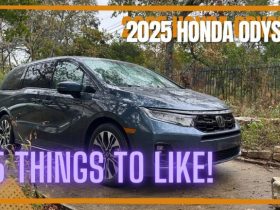The 2024 Nissan Ariya is an all-electric, small SUV-sized model with just about the right balance of size and interior space. It’s roughly equivalent to the high-selling Rogue in footprint, but a little shorter and squatter by comparison. The outgoing Nissan LEAF EV, one of the most popular electric vehicles ever, will be replaced soon. But not by the Ariya.
The new Ariya has all of the things we’d like to see in a newly-minted LEAF. It’s right-sized, it has a comfortable ride, there are two battery options (205/216 miles and 289/304 miles per charge, depending on model choice), and a Tesla Supercharger adaptor since everyone is moving to that starting next year. It’s also got some low rent aspects, such as its slow “fast charger” input, lack of one-pedal driving, and yesteryear infotainment offering.
Nissan plans a different vehicle for it’s upcoming empty LEAF slot, probably based on the Chill-Out Concept shown in 2021. That’s too bad because the Ariya could definitely be a solid LEAF replacer. All it needs is a lower price tag. Which Nissan gave it this year. But not enough of a cut to make it fall into LEAF territory, with the entry point for the 2024 Ariya being about $41,000. The starting price for the 2024 LEAF is about $29,000, for comparison.
Whatever replaces the LEAF, it’ll likely be smaller than the Ariya. C’est las vie.
The good news is that the 2024 Nissan Ariya isn’t too bad. It has some downers, but for the most part, it’s a pretty good entry into the small EV category. My greatest beef with it, really, is the price tag versus what’s included in the vehicle. That $40k-ish entry point is for the base Engage model, which comes with a 214-horsepower motor (front-wheel drive), about 216 miles of range (63 kWh battery), a 12.3-inch center touchscreen, a head-up display, and wireless Apple CarPlay and Android Auto. Plus a bunch of safety equipment and a lot of driver’s aids as standard. That all sounds good.
Except the range as advertised isn’t reality. I usually expect to see within 20 percent of advertised range. I drove a more expensive model with the larger battery pack (87 kWh) option and all-wheel drive. It should have been good for 289 miles per charge, but barely made 230. That’s at the low end of my expectation. Most of the other EVs I’ve driven are much closer to their range estimates.
Another beef I have is with the acceleration and lack of one-pedal driving. The Ariya has great acceleration, which is expected of a modern EV. But you’ll have to use both pedals all of the time. There’s no real “one pedal driving” mode in this Nissan. Which sucks because Nissan did such a good job of that, even pioneering the concept, with the LEAF.
For those who don’t know, one-pedal driving is unique to electrics. Because the motors can brake the car, the use of physical brakes can be minimal. Which reduces one of the biggest maintenance costs of an EV: braking. Which is a low cost compared to the myriad of maintenance requirements for a combustion vehicle. With one pedal driving, the motor engages in reverse to act as a sort of engine brake and aggressively slows the vehicle down (while displaying brake lights). The driver controls using just the throttle and ignoring the brake pedal. It’s a big energy saver and, while it takes some getting used to, it’s a much easier way to control the vehicle. The Ariya can’t do this.
It feels like Nissan missed a big opportunity here. In the LEAF, the one-pedal system was on a toggle, so the driver could decide whether or not to use it. When used, it improves brake regeneration and total range for the car. It really should be in the Ariya.
Charging is another issue. The Ariya is rated at 130 kW maximum for charging. Which means most plug-ins are going to be about 50-80 kW on average. That’s decent, but new vehicles in this price range are usually faster. Real-world charging means a 20-80 percent charge will take about an hour. It’s worth noting, though, that this beef has a big grain of salt on it. Most people charge at home and overnight and perhaps only once a week at that. So most of the time, this slower charge rate is probably not an issue.
That aside, there are seven trim points for the 2024 Nissan Ariya. The Engage is the entry-level followed by the Venture+ which is the hypermiler’s version of the car, stripping out a bunch of amenities and adding a bigger battery to top range at 305 miles per charge. From there, most models build on the Engage into more and more luxurious interiors. Most models are front-wheel drive by default, but AWD is an option. The price tag tops out at about $56,000 with the top-end Platinum+ model.
I liked the 2024 Ariya for its aim. But there are better options on the market. Similarly-sized and priced EVs from Kia, Hyundai, Volkswagen, and coming from Chevrolet are much more competitive.














